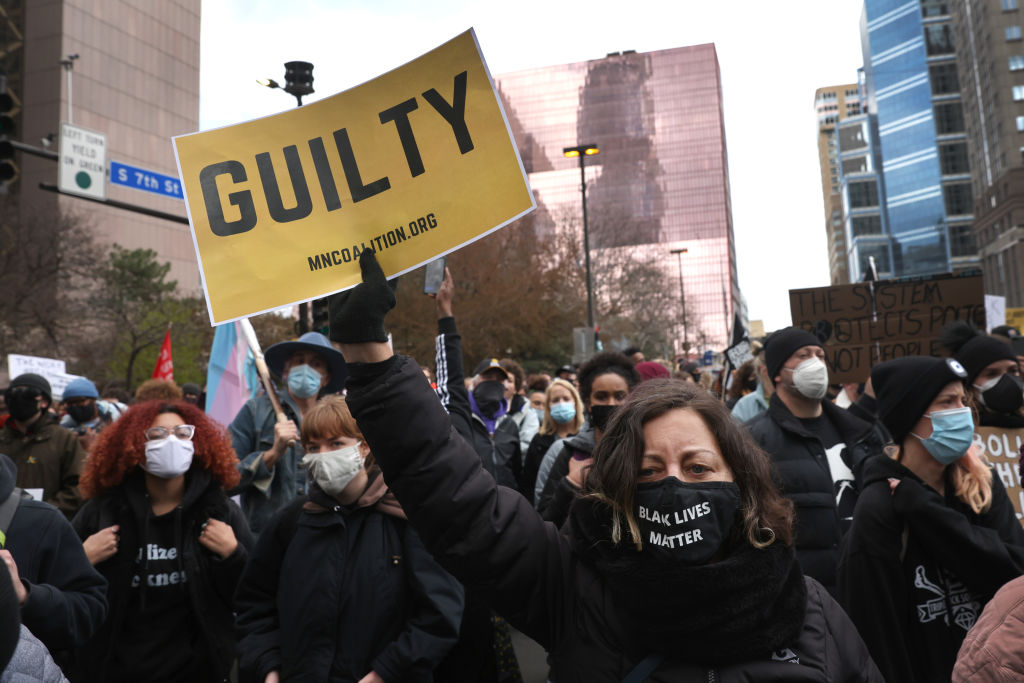Between the abyss and what goes on in Portland and the Magnificent Mile, there is for the moment nothing else but Trump standing in the breach.
The Scapegoating of Derek Chauvin, Pt. I

He did not murder George Floyd.
This is part one of a two-part essay. The second part can be read here.
On the day George Floyd died, May 25, 2020, Amy Sweasy, a prosecutor for the Hennepin County Attorney’s Office with more than 25 years’ experience, was assigned to work on the investigation and prosecution of Officers Chauvin, Thao, Kueng, and Lane. But in early June 2020, Sweasy removed herself from the case due to “ethical concerns.” After she left, Minnesota’s partisan Attorney General Keith Ellison filed new charges against Chauvin, increasing the lead count to second degree murder.
Sweasy later filed suit against her former employer for discrimination and retaliation unrelated to the Floyd matter. The litigation is ongoing, but in August Sweasy’s sworn deposition testimony was released. At 313 pages, the transcript covers her final years as a prosecutor, and a significant portion of her testimony focuses on the tumultuous two weeks following Floyd’s death.
It paints a picture of a prosecutor’s office struggling under the weight of unfamiliar public scrutiny. According to Sweasy, the situation was “extremely” stressful, “there were riots and fires and protests, and it was absolute chaos everywhere.” Michael Freeman, the Hennepin County Attorney, frequently berated the lead prosecutors. “[A]t best,” according to Sweasy, the office was “dysfunctional, at worst…toxic;…there were enormous leadership problems in the office.”
Politicized jargon overrode due process. The brass expressed disdain for “the optics” while contending with Attorney General Ellison’s intervention in the matter. It was Ellison who “ratcheted up the charges against [Chauvin]…to second degree murder,” transforming a case that should have been closed into a political feeding frenzy—one that resulted in the international scapegoating of Derek Chauvin.
The medical examiner’s report and the toxicology report in the context of the putative cause of death, along with the officers’ body camera footage, yield the conclusion that the prosecution massaged the facts to fit a false political narrative that spread across the planet like wildfire.
Quite simply, there never was any basis to bring murder charges against Officer Chauvin.
The Kind of Case That Ends Careers
In her sworn deposition testimony, Sweasy said that early on the morning following Floyd’s death, she called Dr. Andrew Baker, the Chief Medical Examiner for Hennepin County, asking him to prioritize Floyd’s autopsy, which he did. Baker called Sweasy later that same afternoon to report his findings. This is how Sweasy describes the conversation:
He called me later in the day on that Tuesday and he told me that there were no medical findings that showed any injury to the vital structures of Mr. Floyd’s neck. There were no medical indications of asphyxia or strangulation.
Sweasy then quotes Baker as saying:
Amy, what happens when the actual evidence doesn’t match up with the public narrative that everyone’s already decided on? This is the kind of case that ends careers.
These statements are exculpatory and constitute Brady material, or the evidence the prosecutor is required to disclose. It is not conceivable that an honest prosecutor would fail to turn them over in advance of trial, especially since Baker was a key witness for the prosecution. The failure to do so would be reversible error, which results in an unfair trial. While it appears the first statement may have been turned over, it is unclear whether the second was. At any rate, any prosecutor hearing them would immediately develop grave doubts about the strength of the case.
Baker’s autopsy report would have reinforced those doubts. Conducted on May 26, 2020, less than 12 hours after Floyd died, the autopsy revealed:

And:

No life-threatening injuries and no injuries at all to the neck. If you’re surprised to read this, recall that the legacy media undertook the herculean task of browbeating America into believing that Floyd couldn’t breathe because Officer Chauvin’s knee was on his neck, obstructing the passage of air. This was a colossal lie. Floyd’s death had nothing to do with Chauvin’s knee on his neck.
Instead, the autopsy report reveals that Floyd had an incredible amount of fluid in his lungs:

“Edematous” means that Floyd’s lungs were so full of fluid that they weighed between two and three times the normal weight of a healthy adult male’s lungs.
Why were his lungs full of fluid? According to the CDC, it is “common” for fentanyl use to result in the “accumulation of fluid in the lungs,” as well as “significantly reduced respiratory function…low blood pressure [and] abnormal heart rhythms.” That’s relevant because the toxicology report showed that Floyd had various narcotics in his system, fentanyl included—lots of it:

This concoction of 11 ng/mL fentanyl, plus a 5.6 ng/mL norfentanyl and other narcotics, was sufficient to kill him.
On cross examination at trial, Baker acknowledged that he had determined “overdose” to be the cause of death “hundreds of times” in his career, including for decedents who had less fentanyl in their blood than Floyd. He further testified that the fentanyl concentration in Floyd’s blood “would be a fatal level, in other circumstances.” When pressed, he even admitted:
[H]ad Mr. Floyd been found alone, in his locked residence with no evidence of trauma, and the only autopsy finding was [Floyd’s] fentanyl level, then yes, I would certify his death as due to fentanyl toxicity.
In other words, Baker would be willing to conclude that Floyd died of an overdose in the hypothetical situation where Floyd only had fentanyl in his blood, but not in reality where Floyd had fentanyl and methamphetamine. This is difficult to reconcile with Baker’s admission (according to Chauvin’s appeal) that “the methamphetamine in Floyd’s toxicology report caused Floyd’s heart to work harder thereby increasing [the] risk of heart failure.” This last fact is particularly damning to the case against Chauvin because, according to Baker, Floyd also had “severe” arteriosclerosis:

How severe? Baker testified that Floyd’s three largest coronary arteries were severely “narrowed”: the left anterior descending had “75% narrowing,” the first diagonal branch of that same artery also had “75% narrowing,” and his right coronary artery had “90% narrowing.” He further explained that Floyd’s narrowing was from cholesterol, fibrous tissue, and scarring. This is not a description of a chronic health problem, as Baker testified: “75 percent [or] greater [narrowing] [is] capable of causing sudden death.”
That’s not all. Baker also testified that Floyd had “very severe underlying heart disease” and an enlarged heart, a finding reflected in his initial report:

“Cardiomegaly” means Floyd had an enlarged heart. According to Baker, this meant that Floyd’s “heart weighed more than it should” and required “more oxygen than a normal heart by virtue of its size.”
Thus, at the same time fentanyl flooded Floyd’s lungs “significantly reduc[ing] his respiratory function,” methamphetamine caused his heart to pump harder, increasing the strain on a heart already enlarged due to his “hypertensive heart disease,” and forcing blood through coronary arteries that were 75 to 90 percent clogged due to arteriosclerosis, all posing a risk of “sudden death.”
Officious Intermeddler
Amidst this avalanche of evidence that Floyd’s illicit drug use and unfortunate heart problems were the obvious causes of his death, Baker somehow concluded on June 1 that the cause of death was “cardiopulmonary arrest complicating law enforcement subdual, restraint, and neck compression.” (My italics.)
You will notice the odd word “complicating” in the above cause of death. At trial, Baker testified that “complicating” means “occurring in the setting of.” In plain English the cause of death was “cardiopulmonary arrest occurring in the setting of law enforcement subdual, restraint, and neck compression.” A cynic might say that Floyd died because his heart and lungs stopped (cardiopulmonary arrest) while officers restrained him—that is, the restraint was incidental. In fact, that is exactly what an early Hennepin County Medical Examiner’s news release stated: “Decedent experienced a cardiopulmonary arrest while being restrained by law enforcement officer(s).” (Emphasis mine.)
You will also notice the phrase “and neck compression” appended to the cause of death as though it were an afterthought. Turns out it was. In a twist straight out of a John Grisham novel, Dr. Baker added the phrase “and neck compression” after he wrote the initial draft of his report on May 26.
Two suspicious meetings might explain this. First, sometime between May 26 and June 1, 2020 (when his final report was released publicly), an out-of-state, retired medical examiner with no connection to the case or to Hennepin County contacted Baker and expressed his unhappiness with Baker’s failure to include “neck compression” in his draft report (the language of which he may have seen in the original lesser criminal complaint). He also relayed his intent to publish an op-ed critical of Baker in the Washington Post. This bizarre meddling seems awfully like a tacit threat. In public filings, the prosecution denied knowing about this third-party meddling until the fall of 2020, months after the change was made and the charges elevated to second degree murder.
But that denial must be evaluated in light of the second suspicious meeting. In late summer 2020, the trial judge issued an unusual order removing the original Hennepin County prosecutors from the case. The order was issued after the court learned that prosecutors also met with Baker (separate from the meddler’s contact with him) on May 26 to discuss Baker’s draft report (the version without “and neck compression”) but didn’t bring a detective or special agent.
A prosecutor does not meet with a trial witness unless a detective or special agent is present. Ever. To do otherwise risks turning the prosecutor into a witness in his own case.
At any rate, after that meeting, the phrase “and neck compression” was added to Baker’s official cause of death released on June 1 and was quoted by Ellis in his amended complaint charging Chauvin with second degree murder. It was not, however, in the original lesser complaint charged by Sweasy. In her deposition, Sweasy testified that she was criticized for “putting the medical examiner’s conclusions in the complaint.” That is, she was criticized for quoting the medical examiner since his conclusions were (at the time) unfavorable to the prosecution by not mentioning “and neck compression.”
On June 1, 2020, Attorney General Keith Ellison would (or should) have known everything described above: Floyd’s system was saturated in fentanyl and other drugs, and he was drowning in his own bodily fluid; also, he had severe heart disease, substantial narrowing of his arteries, and a heart that was too large. As a result, Floyd’s heart needed “more oxygen,” but his lungs were unable to deliver the extra oxygen because they were edematous. This meant that what little oxygen the lungs could deliver was of limited utility due to “the narrowing of [Floyd’s] coronary arteries.”
Ellison also knew that in the days after Floyd’s death, Hennepin County prosecutors met with Baker without an agent, after which Baker changed his report to add the phrase “and neck compression.” Then, by fall 2020 at the latest, Ellison would have learned that a strange, out-of-state officious intermeddler also contacted Baker about his report and threatened to write a critical op-ed in the Washington Post. From the very beginning, the appearance of impropriety was substantial. It only grew from there.
What, then, is the relevance of the phrase “complicating law enforcement subdual, restraint, and neck compression” appended to Floyd’s actual cause of death—cardiopulmonary arrest? Here’s Baker’s testimony on cross examination:
Now, in the context of an altercation with other people that involves things like physical restraint, that involves things like being held to the ground, that involves things like the pain that you would incur from having your—you know, your cheek up against the asphalt and abrasion on your shoulder, those events are going to cause stress hormones to pour out into your body, specifically things like adrenaline. And what the adrenaline is going to do is, it’s going to ask your heart to beat faster. It’s going to ask your body for more oxygen so that you can get through that altercation. And, in my opinion, the law enforcement subdual, restraint and neck compression was just more than Mr. Floyd could take by virtue of that—those heart conditions.
Stated plainly: Floyd chose to commit a crime. He was apprehended for that crime and became belligerent during that apprehension. The arrest resulted in additional physiological stress and the release of adrenaline. This stress was not excessive by ordinary standards, though it was excessive for Floyd because of who he was and the bad choices he had made. According to Baker, “it was the stress of that interaction that tipped him over the edge given his underlying heart disease and his toxicological status.” It is in this limited sense that the arrest “caused” Floyd’s death—much as riding a roller coaster might have done. But the jump from but-for cause to murder is as preposterous here as it would be to say that a roller coaster murdered Floyd. How do we know? As I’ll explain in Part II, the body camera footage proves that the arrest was conducted in a professional and dispassionate manner.
The American Mind presents a range of perspectives. Views are writers’ own and do not necessarily represent those of The Claremont Institute.
The American Mind is a publication of the Claremont Institute, a non-profit 501(c)(3) organization, dedicated to restoring the principles of the American Founding to their rightful, preeminent authority in our national life. Interested in supporting our work? Gifts to the Claremont Institute are tax-deductible.
Today’s miseducated fame-seekers can’t lead us, unless it’s off a cliff.
A vengeful quest for social purity ends only in public ugliness.
It’s leftists, not Christians, who should be accused of fatalism.
Unless all lives matter, none does.
We've honored a slave-trading tyrant for far too long.






